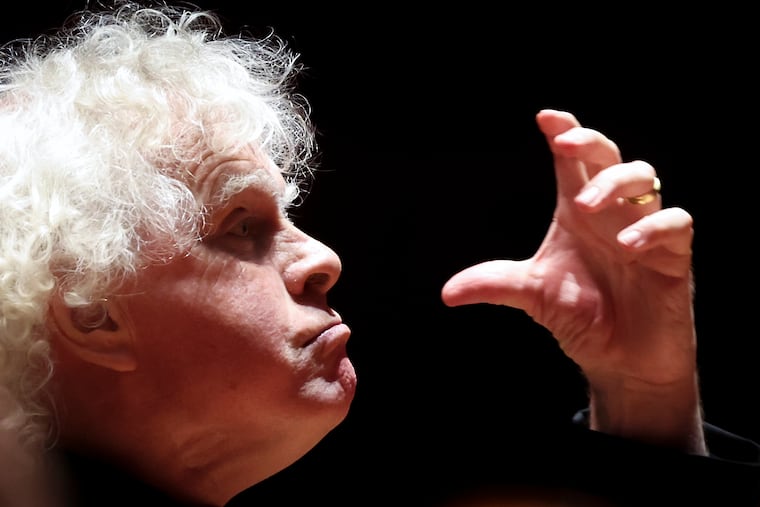Savage, sardonic, and breathtaking: Simon Rattle and Bavarian Radio Symphony Orchestra play the Kimmel
It was the last guest orchestra to visit the Kimmel this season.

In a world of quick hits and superficial encounters, Simon Rattle is a musical deep dive.
It’s not a myth that in-the-moment alchemy accounts for a large part of the conductor’s job. But what Rattle suggested Wednesday night in Verizon Hall is that the important work comes in rehearsal and repeated performances.
It may not be glamorous, this rehearsal business of balancing instrumental sections with one another, working on producing a specific color to convey an emotion, and honing phrases to exactly the right shape. But through craft comes art — and truth. And it was exhilarating to hear Rattle and his Bavarian Radio Symphony Orchestra landing so squarely on both in this season’s last concert of the visiting-orchestra series at the Kimmel.
The full confidence factor in Mahler’s Symphony No. 6 (the program’s sole work) didn’t materialize right away. Rattle and the orchestra have performed and recorded the piece, and Wednesday the first two movements were beautifully done. But the character lines of the piece intensified considerably in the second two movements, and the orchestral palette expanded in breathtaking ways.
Rattle has always seemed like a perfectly nice person, but after the way he handled the third movement you had to wonder about his more sardonic side. The music is marked “scherzo” (joke) and then “wuchtig” (massive, powerful), but the two side by side met emphatically at “savage.” Horns laughed mockingly, the woodwinds jabbed at the air, and the violas, an instrumental section that normally sounds merely worried, bared their teeth.
Musicians have sometimes complained about not being able to hear one another well on the stage of Verizon Hall, but by the time this movement arrived, sections were blending into one anothers’ sound (flutes and violins). I loved the way the music winded down at the end in speed and vigor, like a clock in need of rewinding.
Rattle is an exacting colorist — like Esa-Pekka Salonen, who this month leads the Philadelphia Orchestra for a couple of weeks — and of course the players themselves are the ultimate owners of their sound, which in general carries an impressive amber glow. The strings are particularly solid and warm.
And the ensemble sound was incredibly varied, especially in the “Andante,” where English horn and French horn were expansive and full of character. The hush after a volcanic climax arrived as consolation, but later, when Rattle moved apace, the real destination point that emerged felt like liberation itself.
Of all the Mahler symphonies, it’s probably the Sixth that settled most consciously and unconsciously in the ears of American film composers. The opening of the last movement sounds like the moments after a cosmic explosion. The movement has the spookiest-ever part written for harps ― not celestial, but jagged and unsettling. Rattle and the orchestra heightened Mahler’s heroism, ecstasy, and the big sweep.
And the big bang. At two points in the last movement, percussionist Christian Pilz walked over to a cartoonishly large hammer, lifted it high, and, with the swiftness of an executioner, lowered it on a large wooden box. A boom and a snap — Mahler’s blow of fates never sounded so frightening (though I wish I could rid myself of intrusive Tom and Jerry thoughts).
Rattle’s philosophy, especially in that last movement, was bifurcated in the way that only the greatest conductors can manage. He had obviously sculpted phrasings to a minute degree of detail. But he also let the music breathe in the moment. One is tempted to put it down to age and experience, but this is who Rattle has been for decades. He’s led a lot of orchestras, and all of them end up sounding like Rattle. Which is to say, the most deeply considered realization of the score at hand you’re likely to hear for a long while.